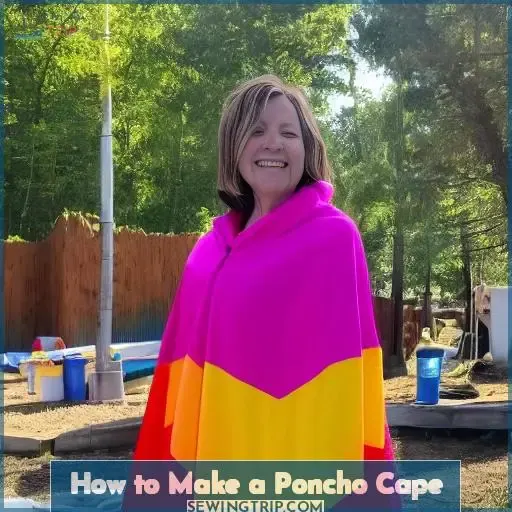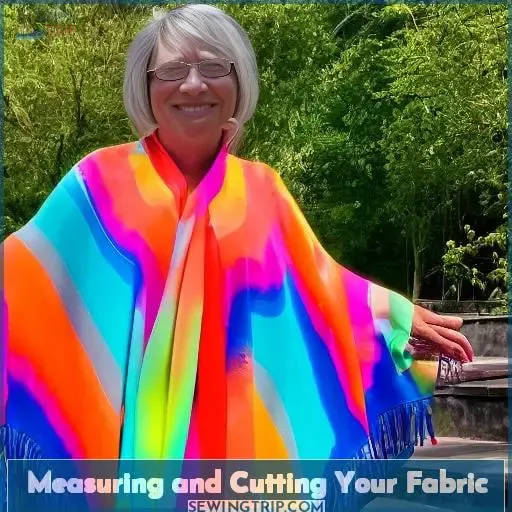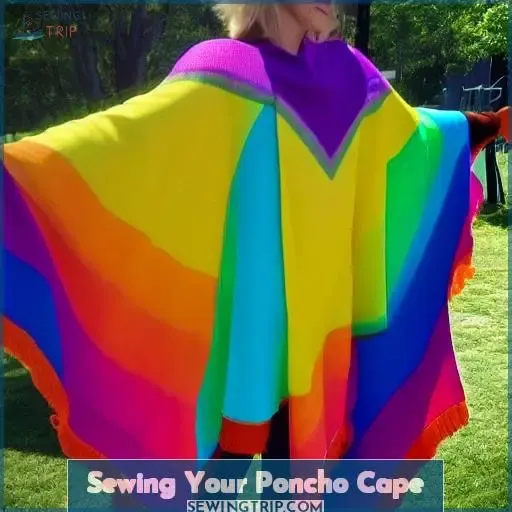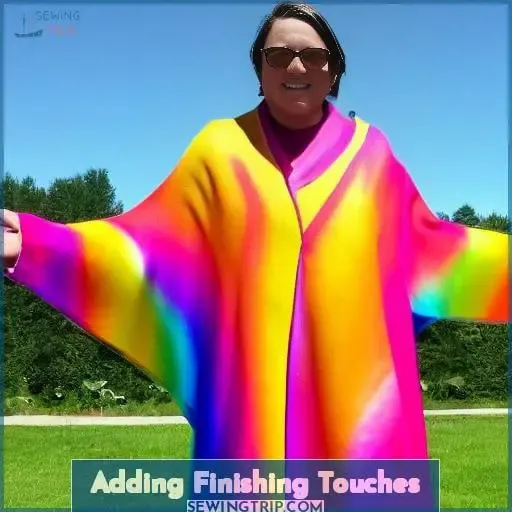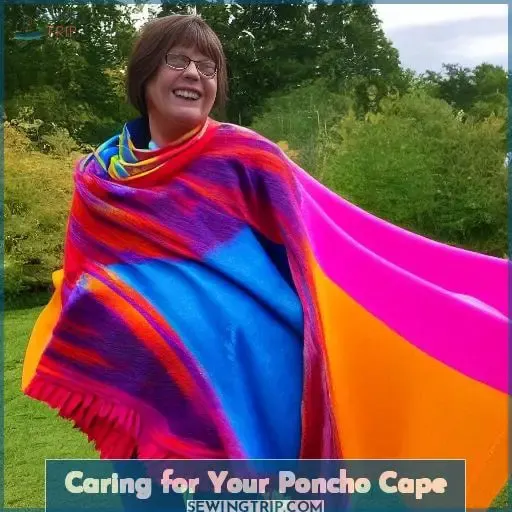This site is supported by our readers. We may earn a commission, at no cost to you, if you purchase through links.
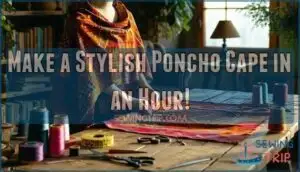
Follow our simple instructions and you can create your very own statement piece that’ll keep you warm all season long. So what’re you waiting for? Let’s get started making the perfect poncho cape today!
Table Of Contents
Materials You Will Need
Get creative and choose a unique fabric or repurpose an old blanket to create your very own poncho cape! To begin, you’ll need sewing tools such as scissors, thread for the desired color selection, and a tape measure. Consider choosing a pattern that best suits your style and any additional styling options like pockets or fringe.
For a heavy knit fabric like fleece, select 4-6 yards of 54-inch wide fabric for added warmth in winter climates. Cut out the fabric according to the pattern instructions; be sure not to cut too close when creating head holes at midpoint along folded edge to prevent fraying with wear and washing!
If adding decorations, now is the perfect opportunity before hemming around edges – think appliques or colorful trim detailing for a child’s fleece superhero cape poncho!
Choosing the Right Fabric
When choosing the fabric for your poncho, consider if you want a lightweight or heavier material; for example, wool is great if you’re looking for a warm and cozy cape. You can also find patterned fabrics to give your poncho some unique embellishments, as well as colorful fabrics that will help create an eye-catching design.
Fleece is a good winter fabric option, but other materials such as cotton or linen are also suitable depending on the type of look and feel you’re going for.
Seam allowances should be taken into account when selecting very easy patterns like those found in circle cutouts. This will avoid any awkward bunching at the neckline, which could make it uncomfortable to wear.
Alternatively, with just two pieces of rectangle-shaped fabric connected with one seam at each shoulder, an easy fabric poncho can be made in no time! Creative use of leftover scraps from old projects means there’s no need to buy excessive amounts of new material either – perfect if cost savings are desired too!
Measuring and Cutting Your Fabric
Measure your body or the person you’re making a poncho cape for and cut your fabric accordingly using scissors. The size of fabric needed depends on the desired length and style – 4-6 yards of 54-inch wide heavy, colorful knit or fleece should do. To add sleeves, use a pattern as a guide when cutting out your pieces from folded edge to get two symmetrical sides with extra fabric in the middle. Choose colors that’ll look good together and hem the edges before adding embellishments like fringes at the ends or pockets on the edges for decorations. Do these steps right and you’ll have an amazing new poncho cape!
Sewing Your Poncho Cape
Now that you’ve measured and cut your fabric, let’s sew the pieces together to create a stylish poncho cape! Start by joining the two sides of fabric together. To secure it in place, use either straight stitches or zig-zag stitches around the edges. You can also embellish your poncho with styling tips such as adding pockets for decoration or fringing techniques along each edge using pre-made fringe.
For an even more creative look, you can upcycle old fabrics and combine different colors into one unique patterned design. If creating a circular head hole is desired, fold a square-shaped piece of material in half before cutting out circles from marked points on both layers at once for symmetry and accuracy when sewing back together.
It’s important to make sure the hemming is done properly around this area so as not to fray any loose threads. If using fleece, there are specific tips available online related to how best to sew those materials too.
With these various options, anyone has all they need no matter their skill level when making their own personalized poncho cape – just have fun with it while exploring color combinations, upcycling ideas, and beyond!
Adding Finishing Touches
Finish your poncho cape with a flourish of decorations to flaunt its fashionable look! Embellishing trims, color selection and fabric texture can all be used to weave patterns that will make the finished poncho stand out. Consider adding a different-shaped head hole or repeating pattern for added flair.
Stitching techniques such as fringing, hemming and binding are also important when making a glamorous looking poncho.
Follow clear instructions on how to add finishing touches like these so you end up with an amazing-looking piece of clothing!
With just some extra effort, you’ll have an eye catching garment that is sure to turn heads wherever you go!
Caring for Your Poncho Cape
Now that you’ve finished your poncho cape, it’s important to take care of it properly so you can enjoy wearing it for a long time! To ensure the longevity and quality of your new garment, here are some tips to help keep your poncho in great condition:
Ironing Tips – Use low heat when ironing most preferred winter fabrics such as fleece used in making superhero capes or colorful sewn ponchos.
Cleaning Methods – Hand wash the fabric or machine-wash cold on a gentle cycle; hang dry using person b detailed photos if needed.
Fabric Protection – Apply fabric protector spray before wearing for added protection against dirt and stains while keeping its original look intact over time.
Color Maintenance – Avoid washing with dark colors which might cause color bleeding, fading, or discoloration due to transfer from other materials during laundering process.
Storage Solutions – Store away from direct sunlight as this may fade out colors; also avoid storing near any form of moisture like wet walls or damp basements since mold could easily set in, causing permanent damage.
With these simple steps, you’ll be able to maintain the quality and beauty of your unique piece for years!
Frequently Asked Questions (FAQs)
What is the best type of fabric for a poncho?
Choosing the right fabric for a poncho is key to creating an attractive, comfortable piece. Fleece is a popular choice due to its softness and warmth; however, other materials such as heavy knit or cotton can also be used depending on size requirements.
For example, if you are making an easy poncho from a square-shaped piece of fabric, then dimensions of a normal couch throw might work well. Alternatively, if aiming for something more asymmetrical, then you may need to purchase additional yardage in order to get the right size shape required.
Dyeing techniques can also be employed in order to create unique colors not available at stores, allowing customisation options when it comes to picking out fabrics suitable for one’s own taste!
Does the size of the fabric affect the size of the poncho?
Yes, the size of the fabric affects the size of the poncho. Consider the type and pattern when selecting fabric. Cutting techniques should also be taken into consideration. You can opt for an asymmetrical design or a circle by marking dots around the edges and connecting them at the center point with straight lines. Hemming options depend on the sewing pattern you use. All edges should meet to avoid openings in the custom sizing poncho. With attention to these steps, you’ll soon have a cozy cape perfect for any occasion!
Is it possible to make a poncho without sewing?
You can make a poncho without sewing, using knotting techniques and cutting methods to alter shapes given any piece of fabric. To create a half-circle poncho you’ll need extra material for the head hole, which can be cut in different shapes for added flair.
If you’re looking for something very practical, there are many patterns available that require no sewing; just some basic fabric options and styling tips!
How do you add fringe to the edges of a poncho?
Adding fringe to the edges of a poncho is easy to do and adds texture and patterns. When choosing fabric for your poncho, keep in mind that heavier fabrics, like fleece, will need more effort to add the fringe. Start by folding the fabric together on one side and make sure you know its center. Mix colors or try squares for a little extra effort and reward. Use a simple zig-zag stitch along both sides of the folded edge to securely attach the fringe.
How can I make my poncho more durable?
If you want to make your poncho more durable, there are a few things you can do. Firstly, take extra care when hemming the seams around the head hole. Use heavier fabric weights and reinforce your stitching patterns with closure types that will hold up better over time, such as buttons or snaps.
Include specific care instructions for laundering and storing, so the material won’t wear down quickly due to improper handling or storage conditions.
With hard work and some creativity – like trying squares instead of circles – you can create a very pretty throw or a very cozy warm cape from slightly bigger pieces of fabric than what’s traditionally used in making ponchos!
Conclusion
You’ve done it! You’ve created a stylish, custom poncho cape. You can now show off your stylish creation to your friends and family.
But the journey doesn’t end there. Taking care of your poncho cape is just as important as making it.
With proper care and maintenance, your poncho cape will last for many years to come. So take a few extra steps to ensure it looks great for years. Hang it up, keep it away from high temperatures, and store it in a safe, dry place.
With a little effort, your poncho cape will be a favorite item in your wardrobe for many years.

